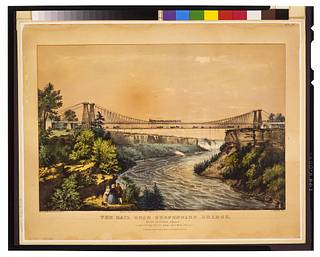
The Rail road suspension bridge: near Niagara Falls
Summary
Print shows sightseers on the lower left at the edge of the Niagara River with a railroad suspension bridge at center and Niagara Falls in the distance.
Caption continues: Length of bridge 822 feet, height above water 340 feet.
Artist: Charles Parsons (signature on image).
Publication date based on copyright statement and/or copyright stamp on item.
Currier & Ives : a catalogue raisonné / compiled by Gale Research. Detroit, MI : Gale Research, c1983, no. 5479
Forms part of: Popular graphic art print filing series (Library of Congress).
New York City from 1835 to 1907 headed first by Nathaniel Currier, and later jointly with his partner James Merritt Ives. The prolific firm produced prints from paintings by fine artists as black and white lithographs that were hand-colored. The firm called itself "the Grand Central Depot for Cheap and Popular Prints" and advertised its lithographs as "colored engravings for the people". The firm adopted the name "Currier and Ives" in 1857.
Niagara Falls is a group of three waterfalls at the southern end of Niagara Gorge, spanning the border between the US state of New York and the Canadian province of Ontario. The largest of the three is Horseshoe Falls, also known as Canadian Falls, which straddles the international border between Canada and the United States. The smaller American Falls and Bridal Veil Falls lie entirely within the United States. Bridal Veil Falls are separated from Horseshoe Falls by Goat Island and from American Falls by Luna Island, with both islands situated in New York as well. Located on the Niagara River, which drains Lake Erie into Lake Ontario, the combined falls have the highest flow rate of any waterfall in North America that has a vertical drop of more than 50 meters (160 ft). Niagara Falls is famed both for its beauty and as a valuable source of hydroelectric power. In 1881, the Niagara River's first hydroelectric generating station was built. The water fell 86 feet (26 m) and generated direct current electricity, which ran the machinery of local mills and lit up some of the village streets. In 1893, Westinghouse Electric designed a system to generate alternating current. In 1896, giant underground conduits leading to turbines generating upwards of 100,000 horsepower (75 MW), we installed.
Tags
Date
Contributors
Location
Source
Copyright info



































